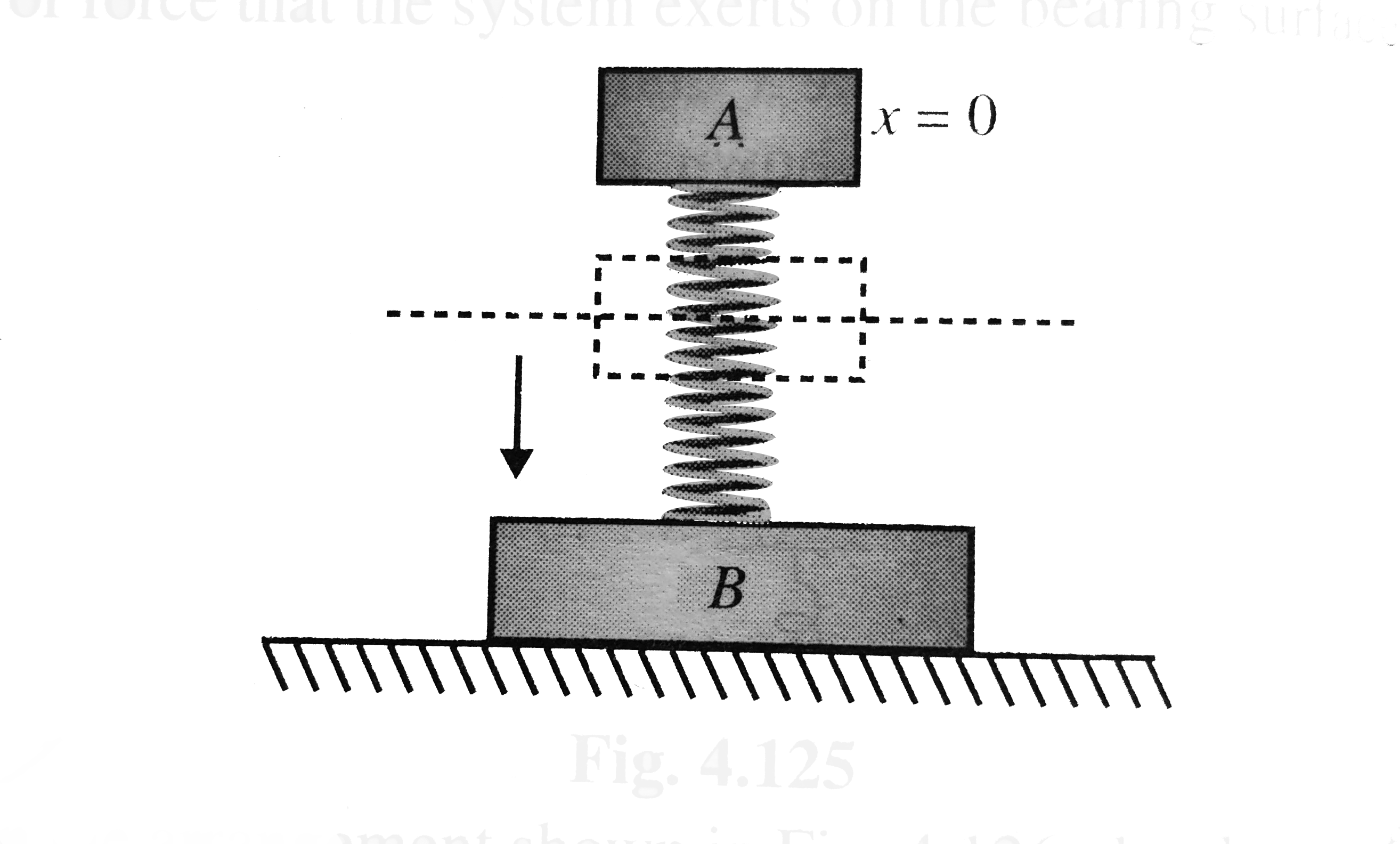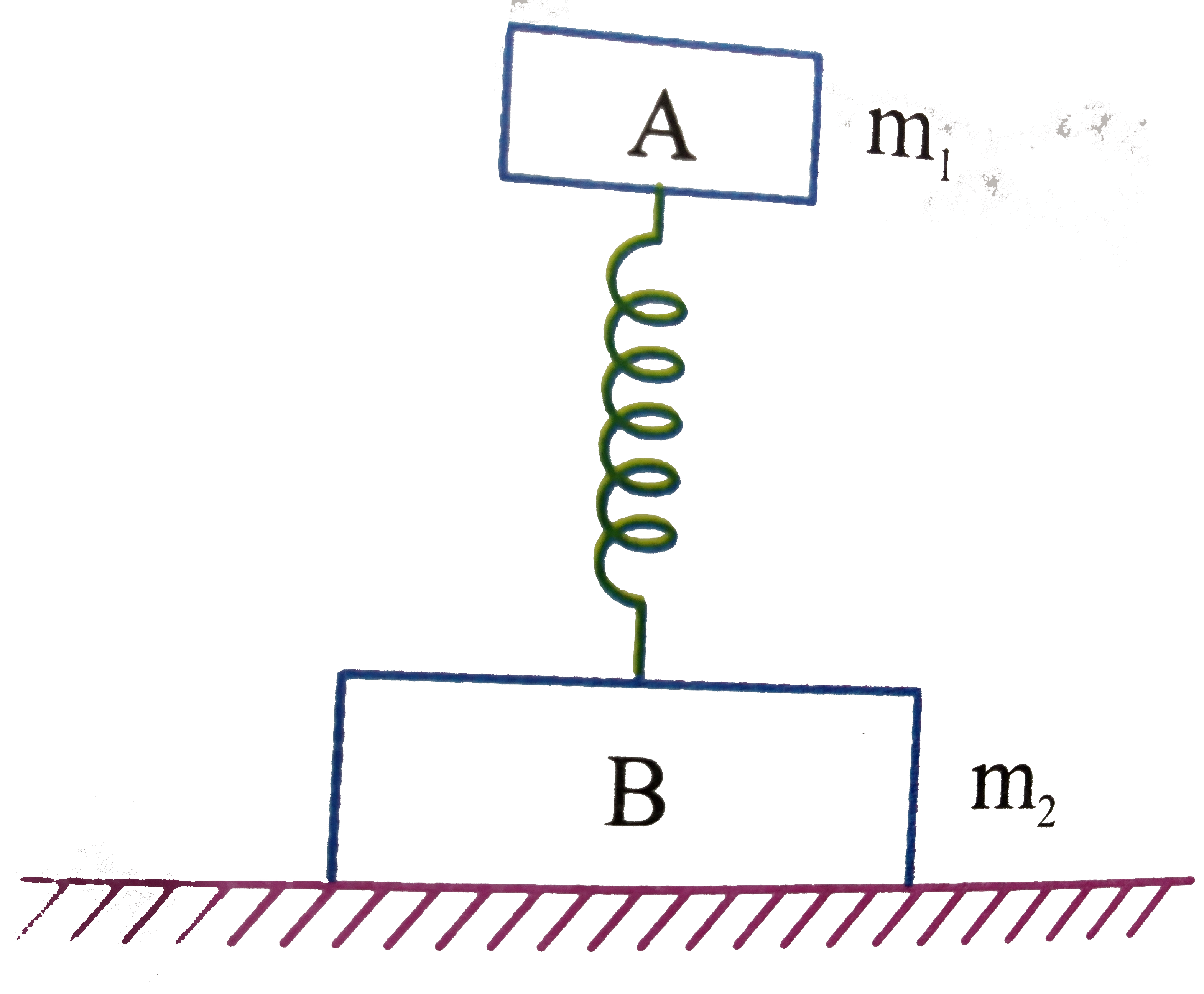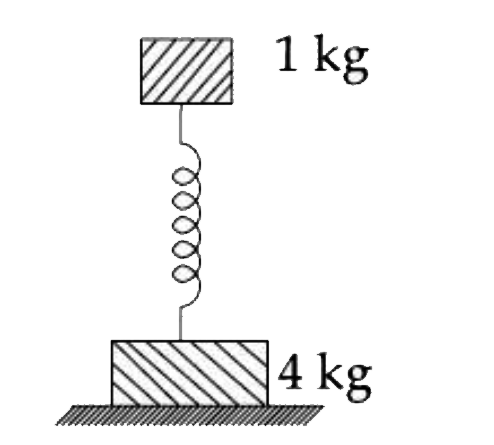A body A of mass m1=1kg and a body B of mass m2=4kg are attached to the ends of a spring. The body A performs vertical simple harmonic oscillations of amplitude a=1.6cm and angular frequencyω=25rads. Neglecting the mass of the spring determine the maximum and minimum values of force the system exerts on the surface on which in rests.
[Take g=10m/s2]

While the body A is at its upper extreme position, the spring is obviously elongated by the amount
(a−m1gk)
If we indicate y− axis in vertically downward direction, Newton's second law of motion in projection form i.e.Fy=mwy for body A gives :
m1g+k(a−m1gk)=m1ω2a or, k(a−m1gk)=m1(ω2a−g)(1)
(Because at any extreme position the magnitude of acceleration of an oscillating body equals ω2a and is restoring in nature.)
If N be teh normal force exerted by the floor on the body B, while the body A is at its upper extreme position, from Newton's second lw for body B
N+k(a−m1gk)=m2g
or, N=m2g−k(a−m1gk)=m2g−m1(ω2a−g) ( using Eqn.1)
Hence N=(m1+m2)g−m1ω2a
When the body A is at its lower extreme position, the spring is compressed by the distance (a+m1gk).
From Newton's second law in projection from i.e.Fy=mwy for body A at this state :
m1g=k(a+m1gk)=m1(−ω2a) or, k(a+m1gk)=m1(g+ω2a).....(3)
In this case if N′ be the normal force exerted by the floor on the body B, From Newton's second law
for body B we get : N′=k(a+m1gk)+m2g=m1(g+ω2a)+m2g (using En. 3)
Hence N′=(m1+m2)g+m1ω2a
From Newton's third law the magnitude of sought forces are N′ and N, respectively.
Topper's Solved these Questions
- BOOK - IE IRODOV, LA SENA & SS KROTOVCHAPTER - OSCILLATIONS AND WAVESEXERCISE - Electric Oscillations56videos
OSCILLATIONS AND WAVES
- BOOK - IE IRODOV, LA SENA & SS KROTOVCHAPTER - OSCILLATIONS AND WAVESEXERCISE - Elastic Waves39videos
OSCILLATIONS AND WAVES
- BOOK - IE IRODOV, LA SENA & SS KROTOVCHAPTER - OPTICSEXERCISE - Exercise2videos
OPTICS
- BOOK - IE IRODOV, LA SENA & SS KROTOVCHAPTER - PHYSICAL FUNDAMENTALS OF MECHANICSEXERCISE - Relativistic Mechanics49videos
PHYSICAL FUNDAMENTALS OF MECHANICS
Similar Questions
A body A of mass m1=1kg and a body B of mass m2=4kg are attached to the ends of a spring. The body A performs vertical simple harmonic oscillations of amplitude a=1.6cm and angular frequencyomeg=25rads. Neglecting the mass of the sppring determine the maximum and minimum values of force the system exerts on the surface on which in rests.
[Take g=10m/s2]
 View Solution
View SolutionA body A mass m1=1kg and body B of mass m2=4.1kg. The body A perform free vertical harmonic oscillations with the amplitude 1.6cm and frequency 25Hz. Neglecting the mass of the spring , find the maximum and m inimum value of force that the system exerts on the hearing surface.
 View Solution
View Solution
Knowledge Check
- Question 1 - Select One
A body A of mass m1 and body B of mass m2 are interconnected by a massless spring as shown. The body A performs free vertical harmonic oscillations with the amplitude A and frequency f. The maximum value of f such that body B does not leave the surface is
 A12π√(m1+m2m2)gAB12π√(m1+m2m1)gAC12π√gAD12π√m2m1.gA
A12π√(m1+m2m2)gAB12π√(m1+m2m1)gAC12π√gAD12π√m2m1.gA - Question 2 - Select One
A ball hung from a vertical spring oscillates in simple harmonic motion with an angular frequency of 2.6 rad/s and an amplitude of 0.075m. What is the maximum acceleration of the ball?
A0.13m/s2B0.20m/s2C0.51m/s2D2.6m/s2 - Question 3 - Select One
Two bodies of masses 1 kg and 4 kg are connected to a vertical spring, as shown in the figure. The smaller mass executes simple harmonic motion of angular frequency 25 rad s−1, and amplitude 1.6 cm while the bigger mass remains stationary on the ground. The maximum force exerted by the system on the floor is (take g=10ms−2).
 A20 NB60 NC40 ND10 N
A20 NB60 NC40 ND10 N
A block of mass 0.5 kg hanging from a vertical spring executes simple harmonic motion of amplitude 0.1 m and time period 0.314s. Find the maximum fore exerted by the spring on the blockl.
View SolutionA body of mass 1 kg oscillates on a spring of force constant 16 N/m. Calculate the angular frequency.
View SolutionA body of mass 0.25 kg is attached to a vertical spring. The spring is executing damped simple harmonic spring will drop to half its initial value ? [The damping constant b = 0.05 kg/s]
View SolutionA body A mass m1 exerts a force on another body B of mass m2 . If the acceleration of B be a2 , then the acceleration (in magnitude) of A is
View SolutionA book is resting on shelf that is undergoing vertical simple harmonic oscillations with an amplitude of 2.5 cm. What is the minimum frequency of oscillation of the shell for which the book will lose contact with the shelf ? (Assume that g=10m/s2)
View Solution
